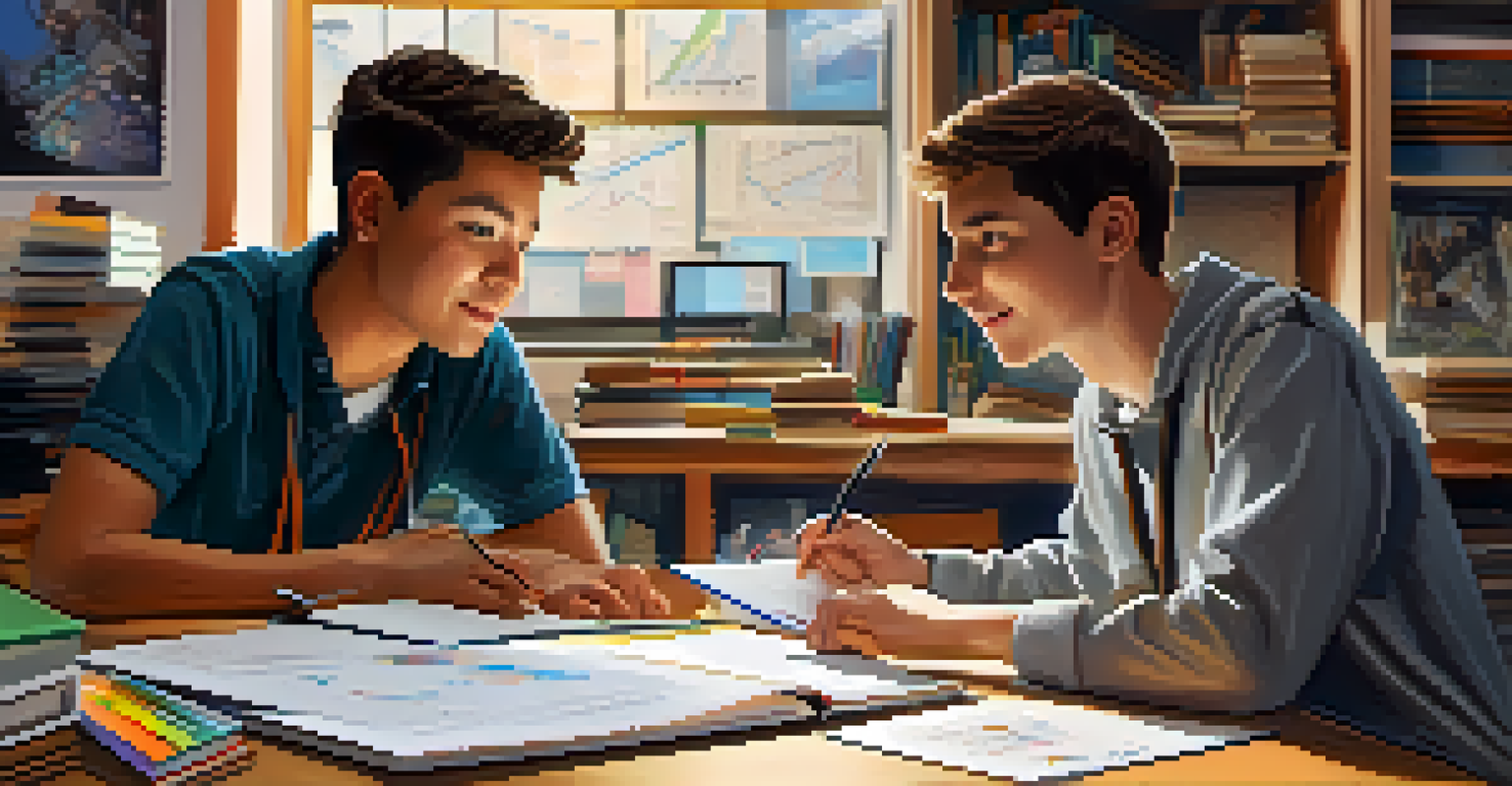Integrating Peer Learning into Project-Based Learning Models

Understanding Peer Learning and Project-Based Learning
Peer learning and project-based learning (PBL) are educational strategies that complement each other beautifully. Peer learning allows students to learn from one another, fostering collaboration and communication skills. Meanwhile, project-based learning immerses students in real-world challenges, encouraging critical thinking and problem-solving.
Learning is a collaborative process. It is through interaction with others that we make sense of our experiences and knowledge.
By integrating these approaches, educators can create an interactive environment where students actively engage with the material. Imagine a classroom where students not only work on projects but also teach and learn from each other through shared experiences. This synergy can lead to deeper understanding and retention of knowledge.
Ultimately, both methods aim to prepare students for real-life situations, making the integration of peer learning into PBL a natural fit. When students collaborate on projects, they develop a sense of community and responsibility towards each other's learning, which is invaluable in today’s interconnected world.
Benefits of Integrating Peer Learning into PBL
Integrating peer learning into project-based learning offers numerous benefits, including enhanced engagement and understanding. When students collaborate, they often explain concepts to one another, reinforcing their own knowledge in the process. This peer explanation is a powerful learning tool, as teaching others often leads to a deeper grasp of the subject matter.

Moreover, peer learning fosters a sense of accountability; students are more likely to invest effort when working alongside their peers. They can encourage each other to stay on track, meet deadlines, and achieve project goals. This collective motivation can transform the learning experience into a more dynamic and enjoyable journey.
Peer Learning Enhances Engagement
Integrating peer learning in project-based learning boosts student engagement and understanding through collaboration and shared explanations.
Additionally, this integration promotes the development of soft skills, such as teamwork and communication. Students learn to listen, provide constructive feedback, and resolve conflicts, preparing them for collaborative environments in their future professional lives.
How to Implement Peer Learning in PBL
Implementing peer learning within project-based learning requires thoughtful planning and facilitation. Start by designing projects that encourage collaboration and group work, ensuring tasks are interdependent. This way, students will need to rely on one another to complete their projects successfully.
Alone we can do so little; together we can do so much.
Next, establish clear roles and responsibilities within groups to help students understand their contributions. Assigning roles can guide interactions and ensure everyone participates actively. For example, one student might take the lead on research while another focuses on presentation skills, allowing each member to shine.
Finally, incorporate structured reflection sessions where students can discuss their experiences and learn from one another. These discussions can help students articulate their learning and further deepen their understanding, making the peer learning experience even more rewarding.
Creating a Supportive Environment for Peer Learning
A supportive environment is crucial for successful peer learning in project-based settings. Begin by establishing ground rules that promote respect, open-mindedness, and active listening. When students feel safe to express their ideas and opinions, they are more likely to engage in meaningful discussions.
Encourage a culture of feedback where students can provide and receive constructive criticism. This not only helps them improve their projects but also teaches them how to communicate effectively with peers. For instance, using structured peer review forms can guide students in offering specific, actionable feedback.
Structured Reflection is Key
Incorporating structured reflection sessions allows students to discuss their experiences, enhancing their learning and peer interactions.
Furthermore, teachers should model effective collaboration and communication skills. By demonstrating how to work with others, educators set a standard for students to follow. Sharing personal anecdotes about teamwork can also make these lessons resonate more deeply.
Evaluating Peer Learning in PBL
Evaluating peer learning within project-based learning can be challenging but is essential for measuring success. One effective approach is to use rubrics that assess both individual contributions and group dynamics. By breaking down the evaluation criteria, you can provide students with clear expectations for their performance.
Additionally, consider incorporating self and peer assessments, allowing students to reflect on their own contributions and those of their teammates. This process can help them develop critical evaluation skills and foster a greater sense of accountability. For example, students might rate themselves and their peers on collaboration, communication, and problem-solving abilities.
Lastly, gather feedback from students about their peer learning experiences. This information can provide valuable insights into what worked well and what could be improved, helping you refine future projects and enhance the overall learning environment.
Challenges of Integrating Peer Learning in PBL
While integrating peer learning into project-based learning has many advantages, it also comes with its own set of challenges. One common issue is the unequal participation among group members, where some students may dominate the conversation while others remain passive. This can lead to frustration and hinder the overall learning experience.
To address this, it's important to monitor group dynamics and intervene when necessary. Teachers can facilitate discussions, ensuring everyone has a chance to contribute and express their ideas. Implementing strategies like 'round robin' sharing can ensure that all voices are heard.
Future Trends Favor Collaborative Learning
Advancements in technology and a focus on social-emotional learning are set to further integrate peer learning into project-based education.
Additionally, some students may struggle with the concept of peer learning if they're used to traditional, teacher-centered approaches. To overcome this reluctance, gradually introduce peer learning activities, starting with low-stakes tasks that build confidence before moving on to more complex projects.
Future Trends in Peer Learning and PBL Integration
As education continues to evolve, the integration of peer learning into project-based learning models is expected to gain even more traction. With advancements in technology, educators can leverage digital tools to facilitate peer collaboration and enhance the learning experience. For example, online platforms can enable students to connect and work on projects together, even from different locations.
Moreover, the emphasis on social-emotional learning (SEL) is likely to influence how peer learning is approached. Educators are recognizing the importance of fostering interpersonal skills and empathy among students, which aligns perfectly with collaborative learning models. This shift will encourage more intentional integration of peer learning into PBL.

Finally, as we witness a greater push for personalized learning, peer learning will play a critical role in allowing students to learn at their own pace while still benefiting from collaboration. This balance between individual and group work can lead to a more holistic educational experience, preparing students for the complexities of the modern world.